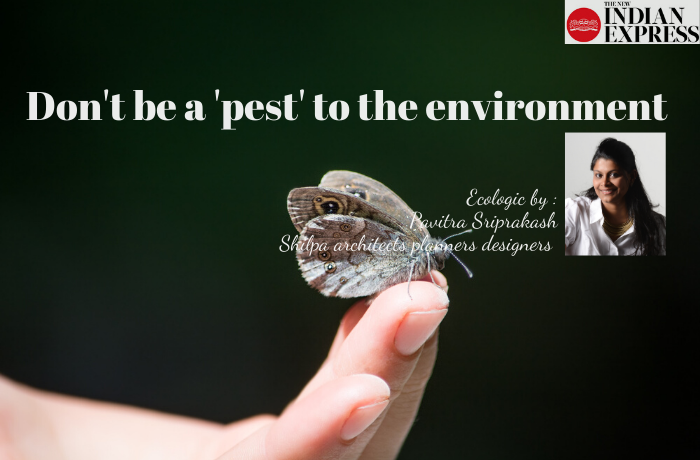31-Oct-2019 : Pavitra Sriprakash, Director and Chief Designer at Shilpa Architects Planners Designers writes a weekly column on Sustainability for The New Indian Express titled “ECOLOGIC”. This week she writes about applying sustainable & human measures for household pest control.
Full article below: (Also available at The New Indian Express Website)
Don’t be a ‘pest’ to the environment
Recently, at a conference on sustainability, I heard someone claim “I am a vegetarian because it is good for the environment, the only thing I kill are mosquitoes and rats!” While their efforts are commendable — being vegetarian (if vegan, even better!) is truly beneficial to the planet — there is some change in the behaviour related to dealing with common household ‘pests’ which could be improved. This lead me to my own quest — how to deal with common household pests in a sustainable way?
We co-exist with other creatures. What is harmful to them is most often harmful to us. Anything that kills them are most likely toxic to humans too — it may not kill us, but definitely will cause some harm to health. Long-term exposure to smoke from mosquito coils can affect the lungs. Sprays that contain pesticides also can cause skin and eye irritations, headaches, dizziness and nausea, weakness, and difficulty in breathing. In extreme cases, it has also been linked with much graver symptoms such as mental confusion, disorientation, seizures, coma, and death. Therefore, natural alternatives are always beneficial. A recent personal find was burning a diya with neem oil and a crushed bay leaf for effectively ridding of mosquitos.
When it comes to rats as well, steering clear of poison is generally a good idea. These are not airborne poisons like the ones for mosquitos, and can very easily seep into the earth and water sources, causing further contamination of the human food chain.The most inhumane of all traps are the glue traps which need to be avoided at all costs. Glue trap manufacturers generally direct consumers to throw away animals along with the trap, leaving the animals to suffer for days until they finally die of stress, starvation, or dehydration — all cruel and painful deaths.
These also remain sticky for a long period of time and continue trapping birds, kittens, reptiles and other small creatures — causing a lot of pain and distress in the process. The most humane method is to setup live traps — trip traps and cage traps are readily available. Even though it is slightly time-consuming, cage traps work effectively with food bait and trap the rodent without hurting it.
These can then be released several kilometers away — so this is a process of displacement rather than total elimination or killing. Ammonia-soaked cotton balls or rags will drive rodents out because they hate the smell. Place them in areas where rat droppings or nests have been seen, and be sure to give the animals a few days to leave. Then, to keep unwelcome ‘visitors’ out, seal entry points using a foam sealant, steel wool, hardware cloth, or metal flashing.
Prevention is better than cure in this case. Sustainable control can only be achieved by reducing the rat or mosquito carrying capacity of the environment, principally by reducing food, garbage, stagnant water and harbourage. Therefore, start in your home by eliminating food sources by keeping counter surfaces, floors, and cabinets clean, and store dry food and ‘pet’ food in chew-proof containers. Seal garbage cans and never feed pet animals outside.So, the next time think of sustainable control, start with preventive measures and then for home remedies that are safer for you and the environment.



